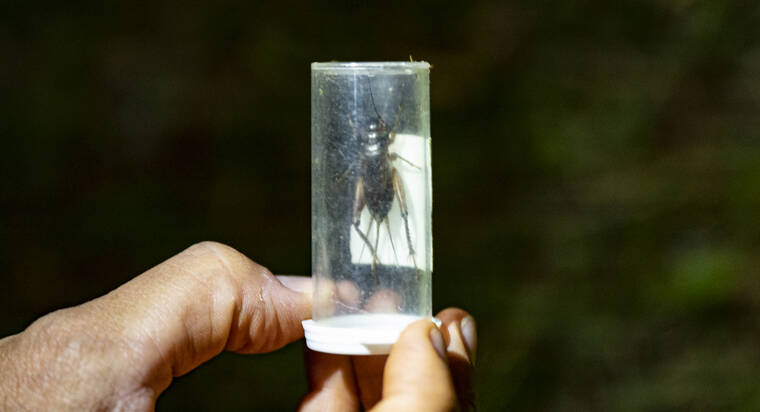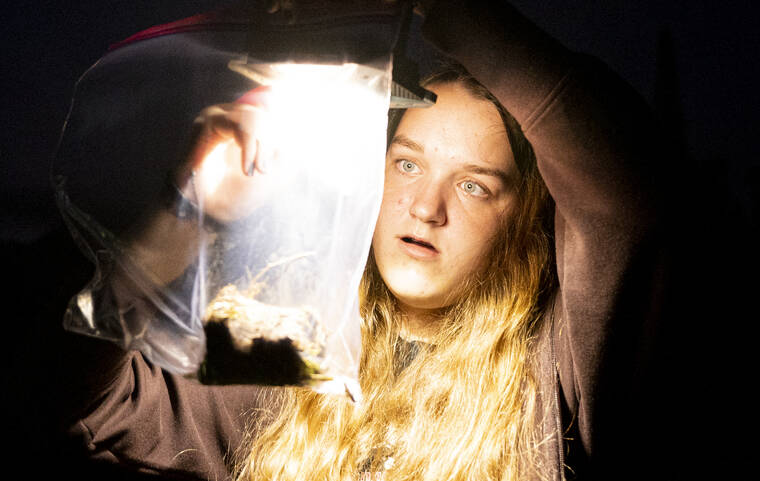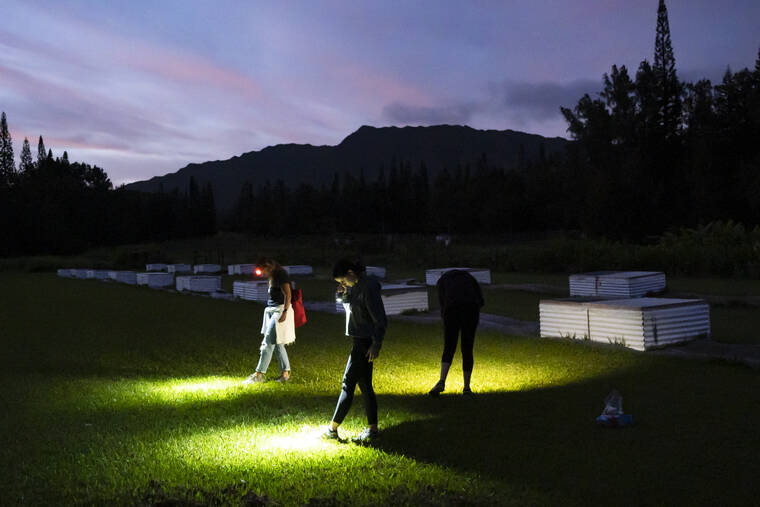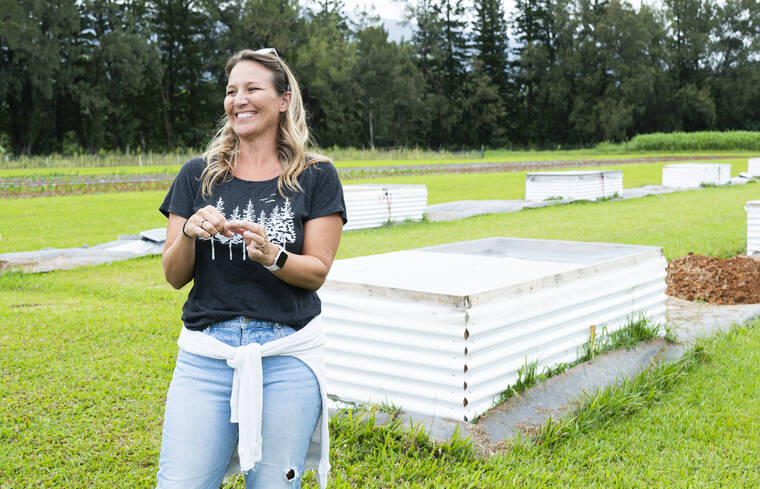WAILUA — After Monday’s sunset, a symphony of insects combined with the swooshing of rubber soles dancing across the matted grass resonated across Wailua’s Hawai‘i Agricultural Experiment Station.
Behavioral and evolutionary ecologist Dr. Robin Tinghitella with researchers and Kaua’i High School students Makayla Karimi and Rachel Chidester performed the “cricket shuffle,” a move where they slide their feet across the grass in an arc pattern to try and expose crickets emerging from their daytime slumber for the night.
The team was collecting data as part of ongoing research about cricket populations in the area.
While plenty of insects could be heard at dusk, the sound of cricket songs was muted.
“There is a real reason that crickets here in Hawai‘i don’t sing until much later in the night,” said Tinghitella. “There is a parasitoid fly that basically locates male crickets that are singing, and it kind of sprays larvae on and around those males. Some of them will burrow into the body cavity of the cricket and literally eat them from the inside out.”
Male crickets face a conundrum. The same song that helps the parasitoid flies find the crickets is also how males attract female crickets and reproduce.
From 2003 to 2008, Tinghitella researched the problem as part of her graduate studies.
“In that time frame, we actually observed a single gene mutation that completely wiped out the cricket’s ability to sing. This particular lawn is where we discovered something called silent flat wing crickets,” said Tinghitella, indicating the experiment station.
A few years ago, Tinghitella observed another mutation. The same species of crickets were now singing a new song.
“This one sounds like a purring cat. So, now all over these lawns at the (agricultural) station here are crickets that produce this song that sounds like a purring cat,” Tinghitella said. “The reason that’s cool is that the female crickets can still hear it and they use it to locate mates. But the parasitoid fly can’t hear it.”
Tinghitella has been traveling to Kaua‘i and collecting data on the crickets since 2003. This year, she took a sabbatical from the University of Denver, where she is an associate professor, to be closer to her research. She is also supporting about a dozen Kaua‘i High School students who are conducting their own research on the cricket populations.
On Monday night, as the team “cricket shuffled” through crop circles set up throughout the agricultural station’s lawn, Makayla spotted a cricket in a small patch of grass illuminated by her headlamp.
Rachel grabbed it and put it in a small specimen container.
“(Makayla) is good at seeing them and I’m good at catching them,” said Rachael. “She’s the eyes and I’m the catcher.”
The team continued the dance for five minutes, noted the number of adult and juvenile crickets and checked to see if the crickets had an ovipositor— a tubular organ below the wings that indicates the cricket is a female.
In the first crop circle, there was just one female cricket. About 100 feet away the team found 11 crickets. The team called that site a “cricket hotspot.”
At each site Makayla and Rachel collected a soil sample.
“What we’re doing is we’re seeing if different components cause (hotspots). We tested soil moisture (and) nutrients like nitrogen, phosphorus, and potassium. And we’re going to see if that accounts for why there’s certain crickets in certain areas,” explained Rachel.
Makayla and Rachael were collecting samples to add more data points to their science fair project. The team won their school competition and is going on to the island-wide competition on Saturday.
As the team counted crickets and collected samples, they hoped that the night’s work would further support their earlier findings and their hypothesis that soil moisture could was an indicator of the size of the cricket population. Dr. Tinghitella brushed off the girl’s concerns. “All data is good data,” said Dr. Tinghitella.
Makayla and Rachael had just a few days to integrate their new data into their presentation for Saturday’s science fair.
Planning time to research in the field has been difficult, with pandemic interruptions not just for Dr. Tinghitella’s students.
This year, only about half as many students participated in the science fair this year as pre-pandemic. Kaua’i Regional Science and Engineering Fair, volunteer coordinator Daniel Matthews organizes the fair and has seen the determination in students who completed projects for this year’s fair. “It really is a story of perseverance with what all of the schools have gone through,” said Matthews.
After Makayla and Rachael collected their data, they released the crickets back into the grass so that their work would not negatively impact the local cricket population. They bagged and labeled their soil samples to analyze at school.
The winning project of the island-wide science-wide fair will go on to compete at an international competition in Atlanta, Georgia.
Regardless of the results, Makayla and Rachael plan to continue their research. Their data did not support their hypothesis that soil moisture was relevant in determining what makes a “cricket hotspot,” so they are designing additional experiments to test different hypothesizes.
Participating in the ongoing cricket research at Wailua’s Hawai‘i Agricultural Experiment Station has been a positive experience for Makayla and Rachael.
“We’ve never really done anything like that. It’s very unique,” said Makayla. “We’re able to get hands-on experience with science in the world instead of just in the classroom.”






